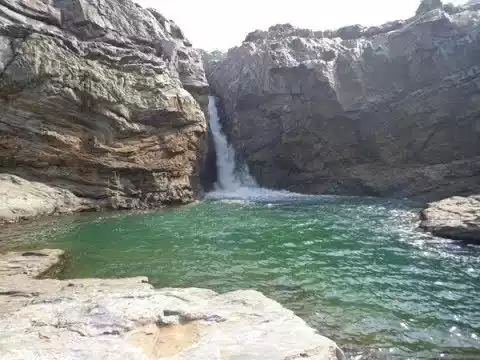Exploring the Rich Heritage of Chatra District
Introduction to Chatra District
Located in the northern part of Jharkhand, India, Chatra District is a region that boasts a rich cultural heritage and diverse geography. This article delves into the various aspects that make Chatra a unique and fascinating place.
Geography of Chatra District
Chatra District is characterized by its hilly terrain and dense forests. The district covers an area of approximately 3,706 square kilometers. It is bordered by Hazaribagh District to the east, Latehar District to the south, Palamu District to the west, and Gaya District in Bihar to the north. The district is part of the Chotanagpur Plateau, which contributes to its varied landscape, including numerous rivers, hills, and valleys.
Rivers and Water Bodies
The major rivers flowing through Chatra include the Damodar, Mohana, and Lilajan. These rivers not only provide water for irrigation but also contribute to the scenic beauty of the district. Several small streams and water bodies dot the region, supporting agriculture and local ecosystems.
Demography of Chatra District
As of the latest census, Chatra District has a population of approximately 1.05 million people. The district has a diverse demographic profile, with various communities living together harmoniously.
Population Distribution
- Urban Areas: Chatra town is the administrative headquarters and the most urbanized area of the district. Other notable towns include Itkhori, Simaria, and Tandwa.
- Rural Areas: A significant portion of the population resides in rural areas, with agriculture being the primary occupation.
Languages Spoken
The official languages are Hindi and Urdu, but several local dialects, including Bhojpuri and Magahi, are widely spoken. These languages reflect the cultural diversity and historical influences in the region.
Cultural Heritage of Chatra District
Chatra District is a melting pot of cultures, traditions, and customs. The cultural landscape is enriched by various festivals, traditional dances, and music.
Festivals and Celebrations
- Chatra Mahotsav: An annual cultural festival showcasing local art, music, and dance.
- Makar Sankranti: Celebrated with kite flying and traditional feasts.
- Durga Puja: A major festival with grand processions and rituals.
Traditional Music and Dance
Folk music and dances such as Jhumar and Chhau are integral to the local culture. These art forms are performed during festivals and special occasions, reflecting the district’s vibrant cultural heritage.
Historical Significance of Chatra District
Chatra has a rich historical background, with evidence of ancient civilizations and significant events during India's struggle for independence.
Ancient History
The region is home to several archaeological sites, including ancient temples and ruins that date back to various dynasties. Notably, the Bhadrakali Temple in Itkhori is believed to have been built during the Gupta period.
Role in Independence Movement
Chatra played a notable role in India's fight for independence. Many freedom fighters from the district participated in movements against British rule, and several historical sites commemorate their contributions.
Cuisine of Chatra District
The culinary traditions of Chatra are a delightful blend of local flavors and influences from neighboring regions.
Popular Dishes
- Litti-Chokha: A traditional dish made of wheat flour dough balls stuffed with sattu (gram flour) and served with mashed vegetables.
- Thekua: A sweet snack made during festivals.
- Dhuska: A deep-fried rice flour snack, often served with chutney.
Ingredients and Cooking Styles
The cuisine of Chatra emphasizes the use of locally grown ingredients such as rice, pulses, and vegetables. Cooking methods are often simple, preserving the natural flavors of the ingredients.
Administration and Governance
Chatra District is governed by a well-structured administrative system that ensures the smooth functioning of various government services.
Administrative Divisions
The district is divided into several administrative blocks, each managed by a Block Development Officer (BDO). The major blocks include Chatra, Simaria, Hunterganj, and Pratappur.
Local Governance
The local governance structure includes Panchayati Raj institutions, which play a crucial role in rural administration. These institutions facilitate community participation in decision-making processes.
Educational and Healthcare Facilities
Education and healthcare are vital sectors in Chatra District, with ongoing efforts to improve accessibility and quality.
Educational Institutions
- Schools: Numerous government and private schools provide primary and secondary education.
- Colleges: Institutions such as Chatra College offer higher education in various disciplines.
Healthcare Services
The district has several hospitals and healthcare centers, including the Chatra District Hospital, which provides essential medical services to the population.
Tourist Attractions in Chatra District
Chatra District offers several attractions for tourists, ranging from natural beauty to historical sites.
Natural Attractions
- Kunda Cave: Known for its prehistoric rock paintings.
- Tandwa Hills: Popular for trekking and nature walks.
Historical Sites
- Bhadrakali Temple: A significant religious site with ancient architecture.
- Kolhua Hill: An important archaeological site with historical ruins.
Suggested Diagram
To illustrate the administrative divisions of Chatra District, the following mermaid diagram can be used:
Conclusion
Chatra District, with its rich history, diverse culture, and scenic landscapes, offers a unique blend of tradition and modernity. From ancient temples and vibrant festivals to its varied cuisine and natural beauty, Chatra is a district that captures the essence of Jharkhand's heritage. The ongoing development in education and healthcare further enhances the quality of life for its residents, making it a promising region with much to offer.
